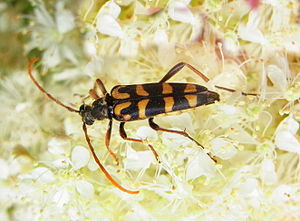Arched neck trestle
| Arched neck trestle | ||||||||||||
|---|---|---|---|---|---|---|---|---|---|---|---|---|

Arched collar buck, female on meadowsweet |
||||||||||||
| Systematics | ||||||||||||
|
||||||||||||
| Scientific name | ||||||||||||
| Leptura annularis | ||||||||||||
| ( Fabricius , 1801) |
The Arcuate neck Bock ( Leptura annularis , Syn. : Strangalia arcuata ( Panzer , 1793)) is a beetle from the family of the longhorn beetle and the subfamily of the narrow blocks .
The generic name Leptura is derived from ancient Greek λεπτός 'leptós' 'thin' and οὐρά 'ourá' for 'tail' and refers to the tapering abdomen. The formerly species-rich genus Leptura was split up and today only comprises four species in Europe. The species name annularis ( Latin for 'provided with rings') as well as arcuata (Latin for 'arched') refer to the foremost transverse stripe of the wing covers, which is curved like a ring in Leptura annularis .
Characteristics of the beetle
The elongated beetle becomes twelve to seventeen millimeters long. The elytra are drawn black and yellow. The antennae and legs are partly yellow-brown in the male and predominantly in the female. The whole body and legs are covered in fine silky hair.
The triangular elongated head is directed forward as an extension of the body axis, the mouthparts are only slightly inclined downwards. The head is dotted and black, it is only lightened around the brown mouthparts. It is depressed between the protruding eyes . The eleven-part antennae are deflected in front of the bulge of the eyes. In the male, the antennae are almost body-long, in the female they are shorter. They are not ringed. In the female they are completely yellow-brown, in the male they are black at the base and the last four to six antennae segments are yellow-brown. Behind the eyes, the head narrows to a neck behind the only short temples.
The pronotum expands bell-shaped after the constriction at the front edge. It is only significantly longer in the male than wide at the base. The base is bulged to the rear in front of the label, next to it is edged towards the front (double-indented). The corners of the base are pointed and hug the shoulders. The pronotum is black and like the head more or less conspicuously hairy golden brown. In the anterior third it is somewhat widened laterally, but without a hump.
The elongated elytra are somewhat narrower in the male than in the female. At the base they are barely wider than the pronotum, towards the rear they narrow almost in a straight line in the male, and slightly bulged in the female. In the end, they are cut off at an angle and the outside corner of the section is drawn out. The wing covers do not completely cover the abdomen. They are roughly dotted and finely haired. They wear four eye-catching yellow cross bars on a black background. The first runs in a horseshoe shape on the base of each wing cover with the opening towards the rear. The following ones extend, roughly evenly distributed over the length of the wing cover, relatively straight over both wing covers, widening towards the seam.
The legs are long, especially the hind legs. In the female they are mostly light brownish, in the male they are mostly darkened. The front hips hang down like a cone. The rear rails are more curved in the male than in the female. The tarsi are apparently four-limbed because the small fourth limb in front of the claw limb is hidden in the bulge of the third limb.
biology
The beetles appear on flowers in June and July. The larvae develop in coniferous wood or in hardwood ( alder ). The stenotopic species is found in the mountains on forest meadows and on the edges of the forest on various flowers.
distribution
The species montane occurs in Central Europe . The distribution area extends from eastern France east to Korea and Japan . The species is absent in northern and southern Europe, in Italy it is only represented in the north.
literature
- Heinz joy, Karl Wilhelm Harde, Gustav Adolf Lohse (ed.): The beetles of Central Europe . tape 9 . Cerambycidae Chrysomelidae . Spektrum Akademischer Verlag, Munich 1999, ISBN 3-8274-0683-8 (first edition: Goecke & Evers, Krefeld 1966).
- Ètienne Mulsant: Histoire Naturelle de Coléoptères de France Volume 1. Paris, Lyon 1840 as a Google book
Individual evidence
- ↑ a b Leptura annularis in Fauna Europaea. Retrieved August 24, 2012
- ↑ Sigmund Schenkling: Explanation of the scientific beetle names (genera)
- ↑ Leptura at Fauna Europaea. Retrieved August 24, 2012
- ↑ Sigmund Schenkling: Explanation of the scientific beetle names (species)
- ↑ Klaus Koch : The beetles of Central Europe . Ed .: Heinz Freude . tape 3 : ecology . Goecke & Evers, Krefeld 1992, ISBN 3-87263-042-3 .
- ↑ a b Adolf Horion : Faunistics of the Central European Beetles, Vol. XII . Überlingen-Bodensee 1974
- ↑ Distribution map France to INPN